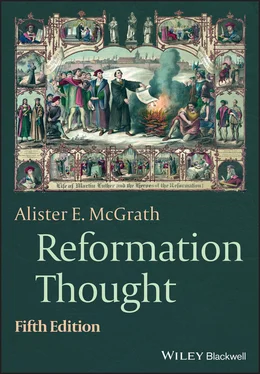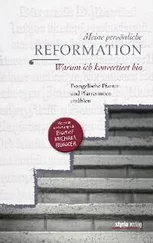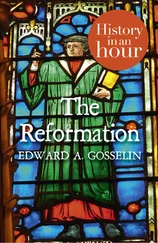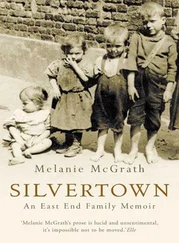3 Title page Reformation Thought An Introduction Fifth Edition Alister E. McGrath
4 Copyright
5 Preface to the Fifth Edition
6 How to Use This Book
7 Chapter 1: Introducing the Age of Reformation The Concept of “Reformation”The Lutheran ReformationThe Reformed ChurchThe Radical Reformation (Anabaptism)The Catholic ReformationThe English ReformationThe Call for ReformThe Growth of Anti-ClericalismThe Need for Doctrinal ReformA Failed Attempt to Reform: ConciliarismThe Growth of Regional and National PowerThe Religious Agendas of the ReformersFor Further Reading
8 Part One: The Context of the Thought of the Reformation Chapter 2: A Changing World: The Cultural Backdrop to the Reformation The Rise of the Individual: The Demand for Personal RelevanceAlternative Theologies: Folk Religion and MagicReligious Democratization: The Use of the VernacularThe Importance of PrintingThe Urban Context of the ReformationSacralizing the Secular: Christianity as a World-Engaging FaithDoctrinal Confusion: A Crisis of Authority Within the ChurchReceptivity Toward the Reformation: The Case of LollardyFor Further Reading Chapter 3: Renaissance Humanism and the Reformation The Concept of “Renaissance”The Concept of “Humanism”Classical Scholarship and PhilologyThe New Philosophy of the Renaissance?Paul Oskar Kristeller’s View of Humanism Ad fontes : Returning to the FountainheadNorthern European HumanismThe Northern European Reception of the Italian RenaissanceThe Ideals of Northern European HumanismEastern Swiss HumanismFrench Legal HumanismErasmus of RotterdamErasmus’ Critique of the Vulgate Text of the New TestamentErasmus’ Editions of Patristic TextsNetworks of Influence: Erasmus’ CircleHumanism and the Reformation: An EvaluationHumanism and the Hebrew BibleHumanism and the Swiss ReformationHumanism and the Wittenberg ReformationTensions Between Reformation and HumanismFor Further Reading Chapter 4: Scholasticism and the Reformation The Characteristics of ScholasticismScholasticism and the UniversitiesTypes of ScholasticismRealism Versus NominalismIntellectualism Versus VoluntarismPelagianism Versus AugustinianismThe Via Moderna The Schola Augustiniana Moderna The Impact of Medieval Scholasticism upon the ReformationLuther’s Relation to Late Medieval ScholasticismCalvin’s Relation to Late Medieval ScholasticismProtestant Scholasticism: Paradox or Inevitability?For Further Reading Chapter 5: The Reformers: Seven Biographical Sketches Martin Luther (1483–1546)Huldrych Zwingli (1484–1531)William Tyndale (c.1494–1536)Philip Melanchthon (1497–1560)Martin Bucer (1491–1551)Katharina Schütz Zell (c.1497–1562)John Calvin (1509–64)For Further Reading
9 Part Two: The Core Themes of Reformation Thought Chapter 6: The Return to the Bible Scripture in the Middle AgesMedieval Hermeneutics: The Four Senses of ScriptureThe Vulgate Translation of the BibleMedieval Vernacular Versions of ScriptureThe Humanists and the BibleThe Bible and the Protestant ReformationThe Canon of ScriptureThe Authority of ScriptureThe Role of TraditionMethods of Interpreting ScriptureThe Right to Interpret ScriptureThe Translation of ScriptureEncouraging Engagement with the BibleThe Catholic Response: Trent on ScriptureFor Further Reading Chapter 7: The Doctrine of Justification by Faith A Foundational Theme: Redemption Through ChristJustification and Martin Luther’s Theological BreakthroughLuther’s Early Views on JustificationThe Nature of Justifying FaithJustification and the Indulgence Controversy (1517)The Concept of “Forensic Justification”Justification and the Early Swiss ReformationThe Reformed Approach: Bucer and Calvin on JustificationJustification in the English ReformationThe Colloquy of Regensburg (1541): “Double Justification”The Catholic Response: Trent on JustificationThe Nature of JustificationThe Nature of Justifying RighteousnessThe Nature of Justifying FaithThe Assurance of SalvationFor Further Reading Chapter 8: The Doctrine of the Church The Background to the Reformation Debates: The Donatist ControversyThe Context of the Reformation Views on the ChurchLuther on the Nature of the ChurchThe Radical View of the ChurchTensions Within Luther’s Doctrine of the ChurchCalvin on the Nature of the ChurchThe Two Marks of the ChurchThe Structures of the ChurchCalvin on the Church and the ConsistoryCalvin on the Role of the ChurchThe Debate over the Catholicity of the ChurchThe Council of Trent on the ChurchFor Further Reading Chapter 9: The Doctrine of the Sacraments The Background to the Reformation Debates about the SacramentsA Shared Emphasis: The Sacraments and the Promises of GraceLuther on the SacramentsLuther’s Views on the Real PresenceLuther on Infant BaptismZwingli on the SacramentsZwingli on the Real PresenceZwingli on Infant BaptismLuther versus Zwingli: A Summary and EvaluationAnabaptist Views on the SacramentsCalvin on the SacramentsThomas Cranmer: The Real Presence in the English ReformationThe Catholic Response: Trent on the SacramentsFor Further Reading Chapter 10: The Doctrine of Predestination The Background to the Reformation Debates over PredestinationZwingli on the Divine SovereigntyMelanchthon’s Changing Views on PredestinationCalvin on PredestinationPredestination in Later Reformed TheologyThe Weber Thesis: Predestinarian Anxiety and the Origins of CapitalismFor Further Reading Chapter 11: The Political Thought of the Reformation The Radical Reformation and Secular AuthorityLuther’s Doctrine of the Two KingdomsZwingli on the State and MagistrateBucer and Calvin on Magistrate and MinistryThe “Godly Prince” and the English ReformationFor Further Reading Chapter 12: Reformation Thought: Its Diffusion and Impact Agencies of DiffusionBooks: The Transgression of International BoundariesRefugees and the Movement of PeopleThe VernacularConsolidating the Ideas of the Reformation: Some Key TextsCatechismsConfessions of FaithCalvin’s Institutes of the Christian Religion The Impact of Reformation ThoughtThe Protestant Work EthicThe Reformation and Political ChangeThe Reformation and the Emergence of the Natural SciencesProtestantism and the Rise of Modern AtheismReformation Ecclesiologies and the Modern ChurchConclusionFor Further Reading
10 Appendix 1 A Glossary of Theological and Historical Terms
11 Appendix 2 English Translations of Major Primary Sources
12 Appendix 3 Standard Abbreviations of Major Journals and Sources
13 Appendix 4 How to Refer to Major Primary Sources
14 Appendix 5 Referring to the Psalms in the Sixteenth Century
15 Appendix 6 Updating Reformation Bibliographies
16 Appendix 7 Chronology of Political and Intellectual History
17 Notes
18 Index
19 End User License Agreement
1 Chapter 1Figure 1.1 Erasmus of Rotterdam in the print shop of his friend Johannes Fr...Figure 1.2 The 23rd Session of the Council of Trent, 1563. Bridgeman XIR 33...
2 Chapter 3Figure 3.1 The Bo Palace, the historical seat of University of Padua since...Figure 3.2 Erasmus von Rotterdam. Copperplate engraving, 1526, by Albrecht...
3 Chapter 4Figure 4.1 Thomas Aquinas, as depicted by Fra Angelico. Museo di San Marc...Figure 4.2 A fourteenth-century seal of the University of Paris. Woodcut ...
4 Chapter 5Figure 5.1 Martin Luther, after a nineteenth-century lithograph. Martin L...Figure 5.2 Huldrych Zwingli, copperplate engraving by Konrad Meyer 1618...Figure 5.3 John Calvin, engraving by Clement de Jonghe (fl. 1640...
5 Chapter 6Figure 6.1 The “Quadriga” or four-horsed chariot on the Bran...Figure 6.2 The title page of William Tyndale’s English Translation...
Читать дальше

![О Генри - Возрождение Каллиопы [The Reformation of Calliope]](/books/407342/o-genri-vozrozhdenie-kalliopy-the-reformation-of-c-thumb.webp)









